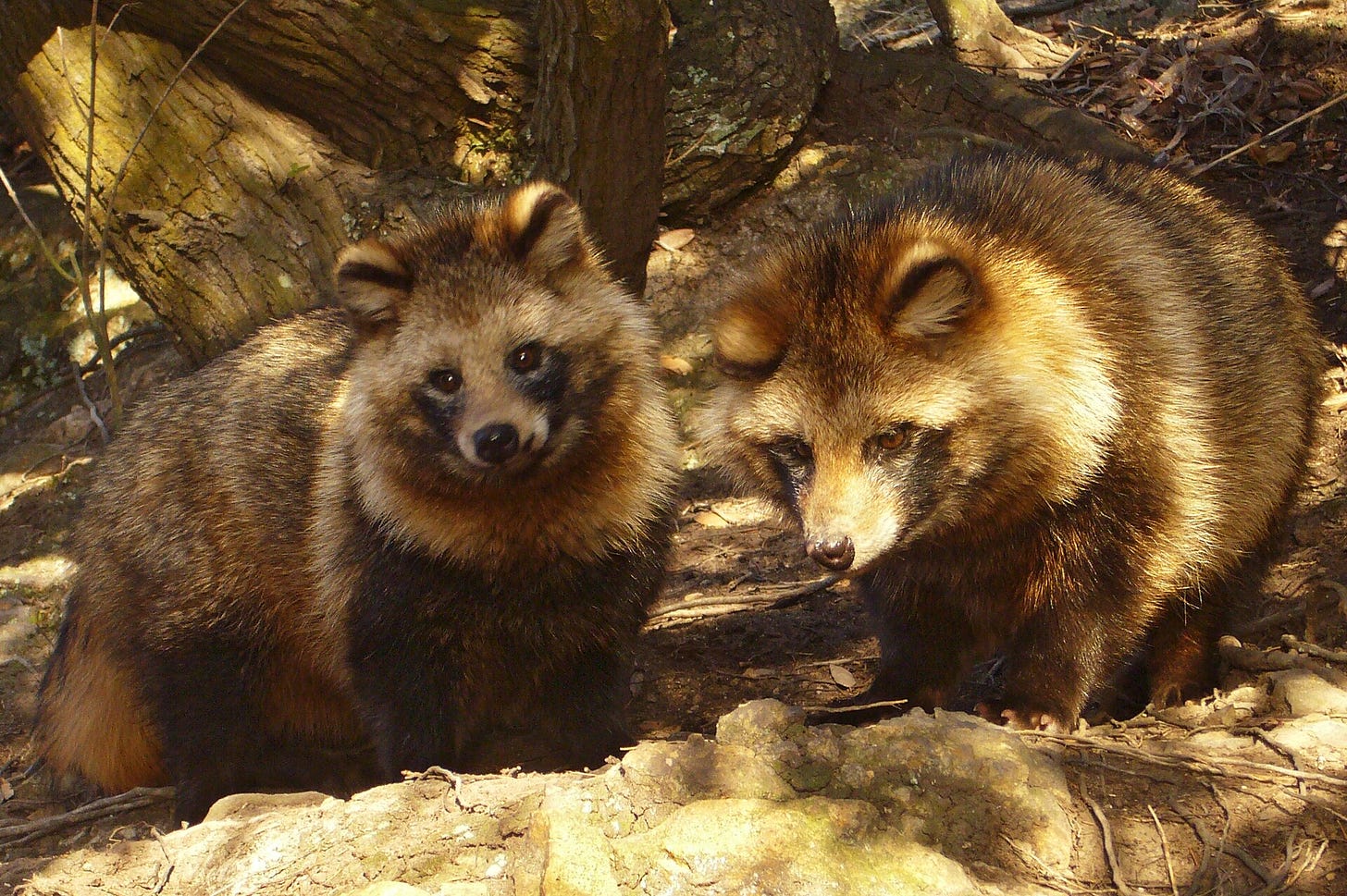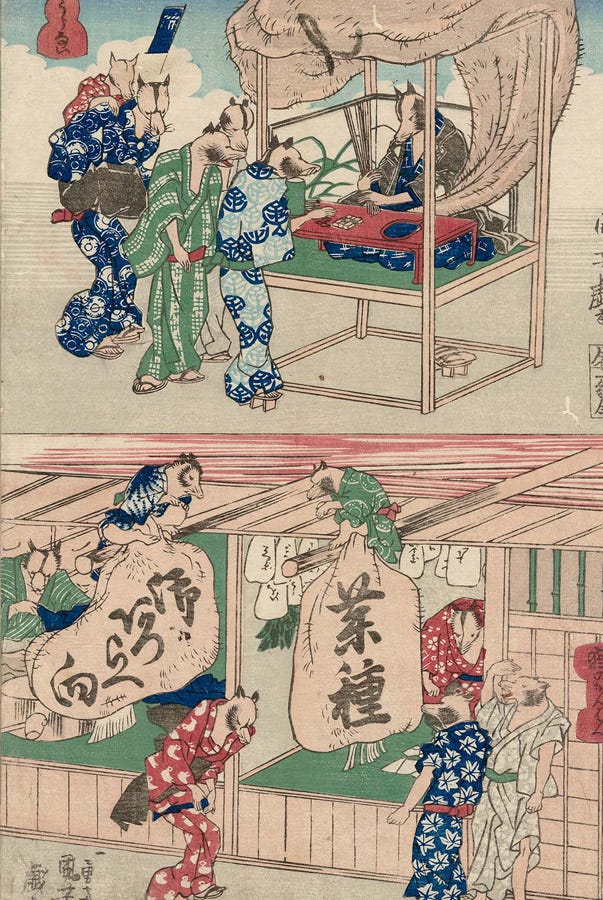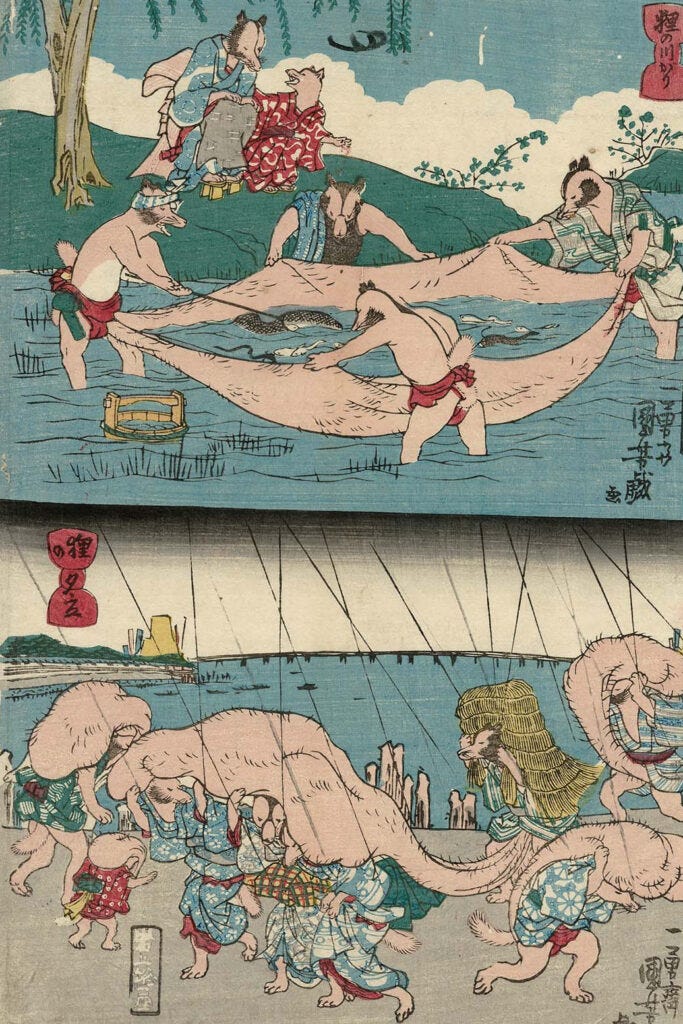Tanuki are one of the most well known yokai, and these tricksters are fun loving and can even bring good luck. There is so much more to them, however, and just like other shapehifting yokai, can be friendly or deadly. Being a very common yokai, there is a lot of information on them, as well as many legends and folk tales about their antics, and I loved researching them for my story Tanuki Troubles.
They also have a second name, which refers only to their yokai counterpart, the bakedanuki, however the name tanuki can mean both the animal and the yokai version. I stuck with tanuki as it’s the more well known name.
Tanuki/Bakedanuki
狸 - たぬき / 化け狸 - ばけだぬき

Tanuki are common throughout Japan, living in forests in the in between worlds of human settlements and mountainous areas. Many lived alongside humans too, even with other yokai such as kitsune. And even in some places, tanuki were revered for their many special abilities and they even became a subject of rituals. Because of this, tanuki are held in the highest regard in those specific areas, such as the Sado Islands in Niigata Prefecture, compared to the rest in Japan.
At first, tanuki played a bigger role in Japanese culture, until Buddhism became more popular. This saw the tanuki move to a similar role to kitsune and other magical animals, and they took the roles of being messengers to gods and guardians. Even with this role, they kept their same mischievous streak of tricking people or having fun, or even snatching humans away for the gods. Many don’t fear the tanuki and believe that each one is unique, just like humans.
This is something that I have been trying to convey in my stories too, how some yokai are different because they have their own thoughts and feelings. In Tanuki Troubles I wrote how a father tanuki acts while trying to care for his daughter, and he showed many human-like emotions. Kitsune are also very intelligent and it also makes sense for them to have many thoughts and feelings of their own. I think about each yokai and how they interact with the world, to work out if they would think and feel as we do. There are some that don’t, for example onibi. I see them as feeling only, like a basic instinct for their desires.
There is also a strange phenomenon to do with tanuki, named Tanuki-bayashi (狸囃子) where in the middle of the night out of nowhere comes musical sounds from the forest, like flutes and drums. The sounds onomatopoeia is "pom poko" or "ponpon".
Shapeshifting
The tanuki’s most powerful ability is that of shapeshifting. They love changing into many forms and will place leaves on their head before doing so. And it isn’t just themselves too, they can also transform leaves and pebbles to look like money to trick unsuspecting humans. It’s also how they manage to interact with others humans, by adopting their ways. Some tanuki even adopt human names and integrate by doing jobs or gambling and drinking their money away. There are tanuki who manage to live their whole life without anyone noticing. However, much like humans, they are known to have a bad reputation too with some thieving, lying, and cheating. Others even transform into oni or other scary yokai to terrorise or scare humans for fun.
There are also tanuki who do the opposite and impersonate Buddhist monks, even teaching Buddhism to others. It has been done so often there is a name for it, tanuki-bōzu (狸坊主), where a tanuki is disguised as a round monk, and they lived in burrows beneath temples.

Tanuki and testicles
A rather surprising ability from the tanuki comes from an unlikely place, their testicles. Tanuki are able to change their body to many forms, and they often use their transforming testicles for many uses, including in their disguises. Testicles can become weapons, drums, fans, umbrellas or nets, and for more elaborate disguises they can be incorporated to become a whole shop or even a boat. Their magical testicles can be adapted for whatever they need.
But where did such a legend come from? Tanuki pelts were used by goldsmiths in the process of hammering gold nuggets into gold leaf. It is said their skin was so good that by wrapping it around the gold it could be hammered out to the size of eight tatami mats. And from there it evolved, and became a symbol of good luck and wealth.
There is even a nursery rhyme about them, learnt by children.
Japanese:
Tan-tan-tanuki no kintama wa,
Kaze mo nai no ni,
Bu-ra bura
English translation:
Tan-tan-tanuki's bollocks,
Even without wind,
They swiiing-swing!

I found all the legends and folk tales about tanuki fun, even the ones about their testicles, however I couldn’t find a way to include it in my story. Maybe next time!
Want to read my story about tanuki? You can read it for free now on Ream by becoming a follower.



